Julian Alden Weir
Paintings
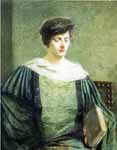
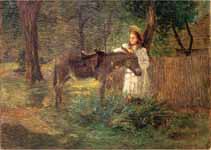
After the Ride ,Visiting Neighbors
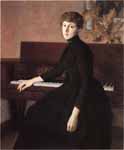
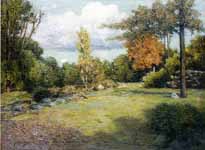
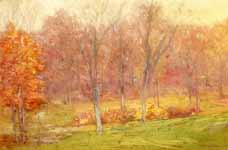
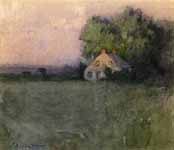
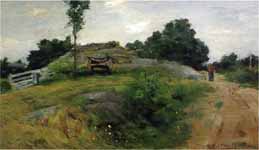
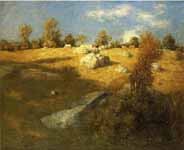
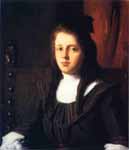

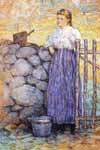
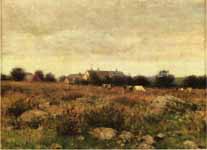
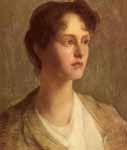
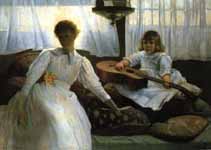
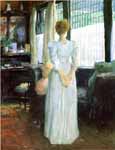
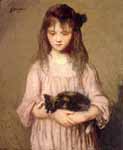
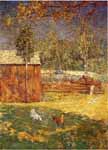
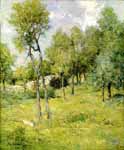
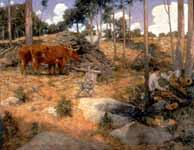
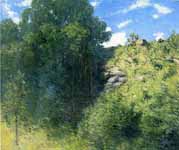
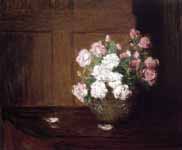
Roses in a Silver Bowl on a Mahogany Table
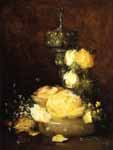
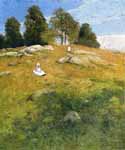
Summer Afternoon Shinnecock Landscape
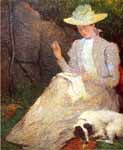

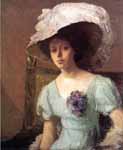
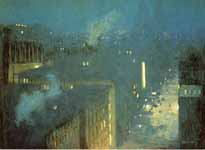
The Bridge Nocturne ( Nocturne Queensboro Bridge)
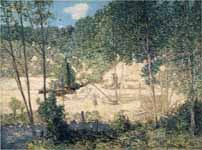
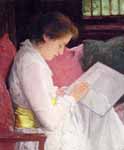
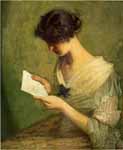
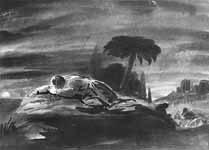
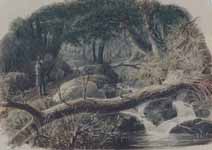
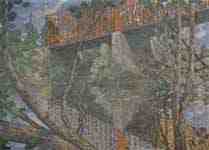
The Red Bridge
---
-----
Julian Alden Weir (August 30, 1852 – December 8, 1919) was an American impressionist painter and member of the Cos Cob Art Colony near Greenwich, Connecticut. Weir was also one of the founding members of "The Ten", a loosely-allied group of American artists dissatisfied with professional art organizations, who banded together in 1898 to exhibit their works as a stylistically unified group.
Biography
Weir was born on August 30, 1852, the second to last of sixteen children,[1] and raised in West Point, New York. His father was painter Robert Walter Weir, a professor of drawing at the Military Academy at West Point who taught such artists as James Mcneill Whistler. His older brother, John Ferguson Weir, also became a well-known landscape artist who also painted in the styles of the Hudson River and Barbizon schools. He was professor of painting and design at Yale University from 1869, starting the first academic art program on an American campus.[2]
Julian Weir received his first art training at the National Academy of Design in the early 1870s before enrolling at the École des Beaux-Arts in Paris in 1873. While in France he studied under the famous French artist Jean-Léon Gérôme, and became good friends with Jules Bastien-Lepage. Weir also encountered impressionism for the first time, and reacted strongly: "I never in my life saw more horrible things...They do not observe drawing nor form but give you an impression of what they call nature. It was worse than the Chamber of Horrors." He complained about the Impressionists in a letter from April 15, 1877 to his parents saying, "They do not observe drawing nor form but give you an impression of what they call nature".[3] As a conservative academic painter at this stage in his career, Weir was esteemed by his European peers during his training years.[4]
Weir met James McNeill Whistler in London before returning to New York City in 1877. Upon his return to NYC, Weir became a charter member of the Society of American Artists and continued exhibiting his work at the National Academy of Design, where he first displayed his paintings in 1875. He earned wages through portrait commissions and teaching art classes at the Cooper Union Women’s Art School, the Art Students League and in private classes.
His works as a young artist centered on still life and the human figure, which he rendered in a realist style not unlike the work of Édouard Manet. This was supported by the fact that Weir purchased two paintings by Manet during the summers of 1880 and 1881, Woman with a Parrot and Boy with a Sword, for the New York collector Erwin Davis.[5] It was clear by then that Weir was beginning to lose his previous staunch loathing for French Impressionism.
In the 1880s Weir moved to rural Ridgefield, Connecticut after having acquired farm property through his marriage to Anna Baker in 1883. While here, he strengthened his friendship with artists Albert Pinkham Ryder and John Henry Twachtman. The art of Weir and Twachtman was especially well-aligned, and the two sometimes painted and exhibited together. Both taught at the Art Students League. In 1889, the two artists exhibited and sold a large portion of their paintings at Ortgies Gallery in New York.[5] Weir was also close friends with the still life and landscape painter Emil Carlsen who summered with Weir on his farm, before purchasing his own home in Falls Village, Connecticut. The pastoral setting of his farms held a special place in Weir’s heart. They were a healthy escape from the hustle and bustle of urban New York City. Weir loved working in the city, but it often became too much for him to bear. Branchville and Windham served as comfortable getaways. He was quoted saying, "Life on the street could often frustrate and aggravate, but contemplated from far off, experienced exclusively as a visual phenomenon, it could satisfy".[6]
By 1891 Weir had reconciled his earlier misgivings about impressionism and adopted the style as his own. His one man show at the Blakeslee gallery in the same year clearly displayed his newfound affinity for the Impressionist style. His work demonstrated a tendency for a lighter palette of pastel colors and broken brushwork akin to the Impressionists.[7] His wife Anna died in 1892, but Weir remarried her sister, Ella Baker, the same year. By this new marriage, he inherited another farm in Windham, CT. This new site was now his rightful property, but it was not the first time he had ever seen the Windham farm. He had been there with Anna in years past. On his first stop there in 1882, the beautiful farm and surrounding village made quite an impact on him. He had this to say: “This is really the first Connecticut village that I have really ever known, & now I feel that a charm is connected with all villages, such as I have read of but never appreciated"[8]
Weir gained further notoriety and in 1893, the American Art Association grouped his works together with those by Twachtman for a comparative exhibit with pieces done by Claude Monet and Paul Besnard.[5] Such a prestigious event meant that the art world had taken notice of the American brand of Impressionism. Furthermore, Weir felt compassion for those who lost their jobs in the 1893 depression. Railroad bankruptcies led to unemployed workers, but Weir helped raise money for them with painting exhibitions.[9]
During the remainder of his life Weir painted impressionist landscapes and figurative works, many of which centered on his Connecticut farms at Branchville and Windham. His style varied from traditional, vibrant impressionism to a more subdued and shadowy tonalism. He also became skilled at etching. As a rule, his paintings done after 1900 showed a renewed interest of the academicism prevalent in the work of his younger days, with subjects treated less realistically and a greater emphasis placed on drawing and design.[7]
In 1897, Weir became a member of the Ten American Painters, generally known as The Ten, a group of painters who left the Society of American Artists in late 1897 to protest the what they saw as the overemphasis on Classical and Romantic Realism over Impressionism by the Society. The Ten exhibited for twenty years until its demise, due to the death of members and the prominence of newer styles.[10]
In 1912 Weir was selected the first president of the Association of American Painters and Sculptors, but resigned a year later following the association's sponsorship of the modernist Armory Show. Weir later became president of the National Academy of Design. He was a member of the U.S. Commission of Fine Arts from 1916 until his death in 1919.[11]
Legacy
The most critically acclaimed painting by Weir is The Red Bridge from 1895. It is a technical masterpiece, displaying a truss bridge that spanned the Shetucket River down the street from Weir’s Windham farm. He used complementary colors to unite the image with equal tonal quality and to depict the realistic reflection of the bridge seen on the water.[12] While there is pictorial unity in the piece, Weir contrasted the bridge and its surrounding setting by placing the red bridge against the greens of woods and the blues of water and sky and by juxtaposing the geometric man-made bridge with the natural sinuous curves of the trunks and branches.[13]
Today Weir's paintings are in the collections of the Metropolitan Museum of Art, New York; the Phillips Collection, Washington, D.C.; the Smithsonian American Art Museum, Washington, D. C.; Brigham Young University's Museum of Art, Provo, Utah; the Portland Art Museum in Portland, Oregon; and the Wadsworth Atheneum, Hartford, Connecticut. Weir's farm and studio at Branchville are protected as the Weir Farm National Historic Site; the Weir family continues ownership of the Windham farm. His papers are in the Smithsonian Institution's Archives of American Art. In Poe's poem Ulalume, "In the ghoal haunted woodland of Weir" is a reference to Weir's paintings upon Poe's imagination. Looking at Albert Pinkam Ryder's seascapes, one also sees other Poe stories.
See also
American Impressionism
Art Students League
Society of American Artists
Ten American Painters
List of J. Alden Weir art
Notes
National Park Service. "Julian Alden Weir". nps.gov. Retrieved 10 April 2014.
Wardle 2011, p. 12.
Young & 1960 123.
Wardle 2011, p. 5.
Bolger, Curry & Weinberg 1994, p. 137.
Clayson 2011, p. 63.
Bolger, Curry & Weinberg 1994, p. 358.
Bolger, Curry & Weinberg 1994, p. 61.
Cummings & Fusscas Larkin, pp. 55–56.
Brockett, Erik. "The Ten American Painters". Antiques & Fine Art Magazine. Retrieved 10 April 2014.
Luebke 2013, p. 557.
Bolger, Curry & Weinberg 1994, p. 140.
Bolger, Curry & Weinberg 1994, p. 83.
References
Bolger, Doreen; Curry, David Parker; Weinberg, H. Barbara (1994), American Impressionism and Realism: The Painting of Modern Life, 1885-1915., New York: Metropolitan Museum of Art, pp. 61, 83, 137, 140, 358, ISBN 978-0810964372
Cummings, Hildegard; Fusscas, Helen K.; Larkin, Susan G. (1991), J. Alden Weir: A Place of His Own, Storrs: William Benton Museum of Art, pp. 55–56, ISBN 978-0918386434
Luebke, Thomas E., ed. (2013), "Appendix B", Civic Art: A Centennial History of the U.S. Commission of Fine Arts, Washington, D.C.: U.S. Commission of Fine Arts, p. 557
Wardle, Marian, ed. (2011), The Weir Family, 1820-1920: Expanding the Traditions of American Art, New Hampshire: UPNE, p. 12, ISBN 978-1611680218
Clayson, Hollis (2011), "Enthralled and Dismayed by Paris: Julian Alden Weir in the Transatlantic World", in Wardle, Marian, The Weir Family, 1820-1920: Expanding the Traditions of American Art, New Hampshire: UPNE, p. 63, ISBN 978-1611680218
Young, Dorothy Weir (1960), The Life and Letters of J. Alden Weir, New Haven: Yale University Press, p. 123
Further reading
Burke, Doreen Bolger (1983), J. Alden Weir: An American Impressionist, Cranbury NJ: Associated University Presses and Cornwall Books, ISBN 0-87413-220-7
Gerdts, William H. (2001), American Impressionism (2nd Edition ed.), New York: Abbeville Press Publishers, ISBN 0-7892-0737-0
Larkin, Susan G. (2005), American Impressionism: The Beauty of Work, Greenwich: The Bruce Museum of Arts and Science, ISBN 978-0711225855
Larkin, Susan G. (2001), The Cos Cob Art Colony, New York: the National Academy of Design, ISBN 0-300-08852-3
Stula, Nancy; Noble, Nancy (2004), American Artists Abroad and their Inspiration, New London: Lyman Allyn Art Museum
Artist
A - B - C - D - E - F - G - H - I - J - K - L - M -
N - O - P - Q - R - S - T - U - V - W - X - Y - Z
Retrieved from "http://en.wikipedia.org/"
All text is available under the terms of the GNU Free Documentation License


